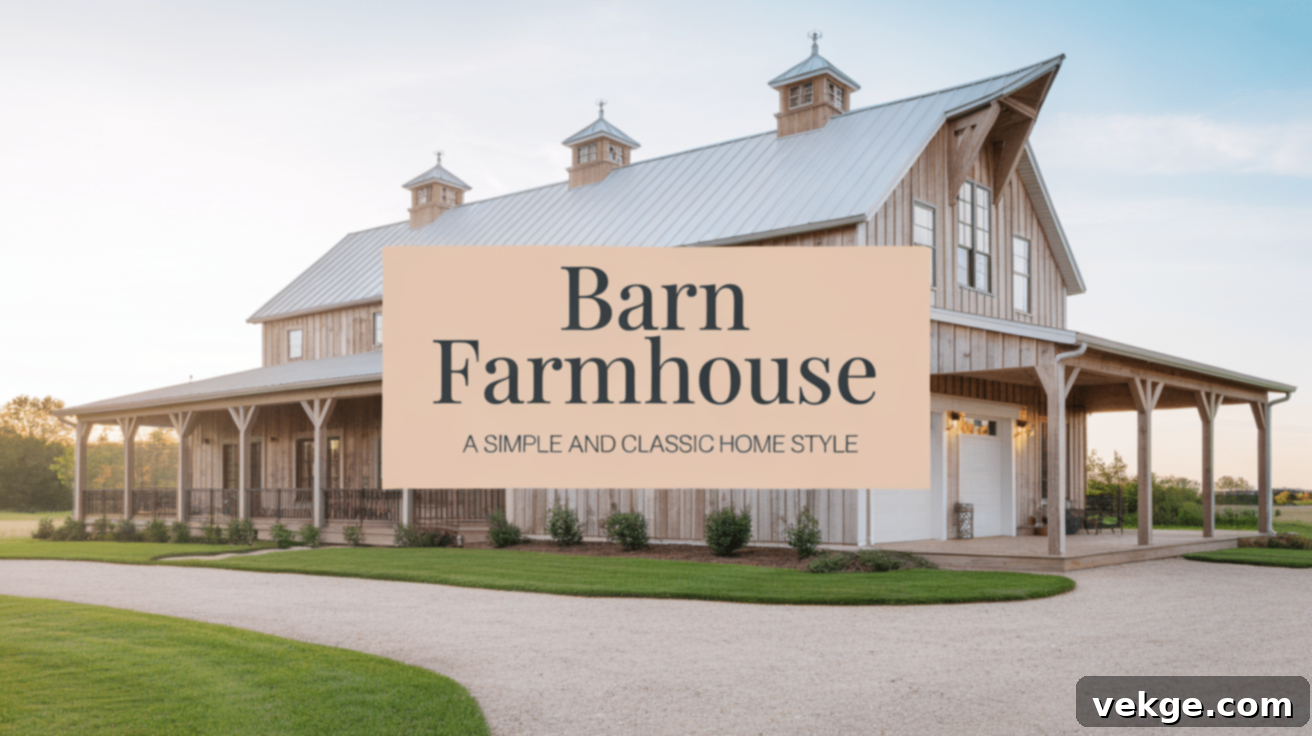Embracing Rustic Elegance: Your Ultimate Guide to Barn Farmhouse Style Homes
The barn farmhouse style possesses a timeless and captivating appeal that gracefully merges classic beauty with a warm, inviting atmosphere. This distinctive design celebrates the charm of natural wood, expansive open spaces, and a subtle nod to history, creating a home that feels both inherently cozy and wonderfully airy.
What makes this style truly exceptional is its accessibility. You don’t necessarily need an old barn or an extensive budget to infuse your home with that coveted farmhouse charm. With thoughtful choices in colors, materials, and decor, even small adjustments can lead to a remarkable transformation. This guide will delve into the unique elements that define a barn farmhouse and provide practical advice on how to seamlessly integrate this beloved aesthetic into your living space. If you appreciate simplicity, enduring design, and spaces that feel lived-in and loved, the barn farmhouse style might be your perfect match.
What Is a Barn Farmhouse?
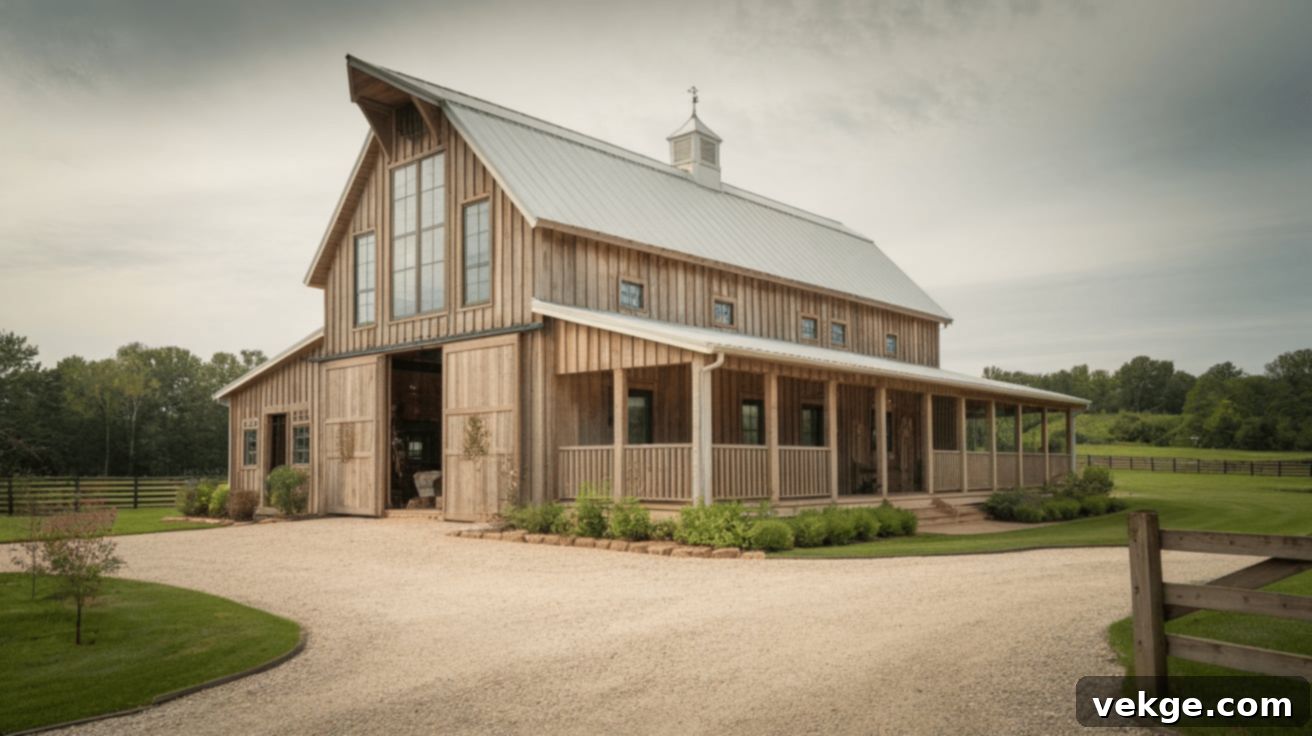
A barn farmhouse represents a distinctive architectural and interior design philosophy that harmoniously blends the structural integrity and rustic essence of traditional barns with the comfort and homeliness of a classic farmhouse. It draws inspiration from the utilitarian yet beautiful forms of agricultural buildings, characterized by their high ceilings, expansive open layouts, and the honest use of natural, often weathered, materials.
This style takes these raw, authentic barn characteristics and infuses them with warm, inviting elements that transform a mere structure into a cherished home. Its enduring popularity stems from its unique ability to bridge historical character with contemporary living needs. Unlike some modern designs that can feel stark or overly minimalist, a barn farmhouse exudes warmth through rich wood textures, vintage-inspired decor, and an abundance of natural materials. It’s a style celebrated for its simplicity, yet it’s rich in personality and soul.
The allure of the barn farmhouse lies in its commitment to creating spaces that feel welcoming, breathable, and deeply connected to nature and a simpler way of life. It emphasizes comfort and authenticity over elaborate ornamentation, focusing on an atmosphere that feels genuine and unpretentious.
Key Features of a Barn Farmhouse
Barn farmhouses are recognized by several distinctive elements that contribute to their unique charm and functionality. Understanding these key features is crucial to capturing the essence of this beloved style.
1. Open Floor Plan
One of the most defining characteristics of a barn farmhouse is its expansive open floor plan. This design philosophy minimizes interior walls, creating large, interconnected spaces that flow effortlessly into one another. Historically, farmhouses often featured a central, large room where families gathered for various activities, from dining to work and social interaction. Modern barn farmhouses beautifully reinterpret this tradition by integrating the kitchen, dining, and living areas into one cohesive space.
This open concept not only makes homes feel significantly larger and brighter but also fosters a more inclusive and welcoming environment. It enhances natural light penetration, improves air circulation, and simplifies entertaining, allowing guests to move freely and interact seamlessly across different zones. For those who love to host, an open layout is undeniably ideal.
2. High Ceilings and Exposed Beams
Barn farmhouses are renowned for their vaulted ceilings, often dramatically accented with exposed wooden beams. This architectural element directly references the practical design of traditional barns, which required tall, unobstructed interiors for storing hay and housing livestock. Today, this feature adds profound character and an immediate sense of grandeur, making a home feel exceptionally airy and spacious.
The visible beams contribute a crucial rustic touch, grounding the space with natural warmth and structural honesty. Whether left in their raw, natural wood finish to highlight their organic beauty or painted white for a brighter, more contemporary farmhouse look, exposed beams consistently serve as a captivating focal point.
3. Wood and Natural Materials
Wood is the cornerstone of barn farmhouse design, appearing in almost every aspect of the home—from floors and walls to ceilings and furniture. The emphasis is always on natural, untreated, or lightly finished wood, celebrating its inherent textures and variations. Reclaimed wood is particularly prized, as it carries a sense of history and adds unparalleled character to any space.
Beyond wood, other natural materials such as stone, brick, and metal are extensively used to enhance the authentic farmhouse feel. Stone fireplaces, exposed brick accent walls, and black iron fixtures (for lighting, hardware, or structural elements) collectively contribute to this rustic aesthetic. These materials imbue the home with a raw, organic quality, forging a strong visual connection to the outdoors and a natural, grounded sensibility.
4. Neutral and Earthy Colors
The barn farmhouse palette predominantly features neutral and earthy tones, which cultivate a calming, soft, and natural atmosphere. These colors serve as a serene backdrop, allowing natural materials and textures to shine. Common color choices include:
- Whites and off-whites: These are classic farmhouse staples, keeping spaces bright, clean, and expansive.
- Beige and light browns: Warm and inviting tones that add a layer of coziness and complement natural wood.
- Grays and charcoal tones: Offering a more modern edge while retaining a rustic, sophisticated feel.
- Soft greens or deep blues: Used sparingly as accent colors, these add depth and a subtle connection to nature without overwhelming the serene palette.
This restrained color scheme promotes a tranquil ambiance and provides a versatile foundation for integrating various furniture styles and decorative accents.
5. Large Windows for Natural Light
Maximizing natural light is a fundamental principle of barn farmhouse design. Large windows are strategically placed to flood interiors with sunlight, enhancing the feeling of openness and airiness. This emphasis on natural illumination not only brightens the space but also highlights the beauty of the rustic materials and textures used throughout the home.
Windows with black metal frames are a popular choice, providing a striking contrast against neutral walls and a simple, refined aesthetic. Many barn farmhouses even feature floor-to-ceiling windows, effortlessly blurring the lines between indoor and outdoor living and offering panoramic views of the surrounding landscape. Abundant natural light is essential for creating the fresh, welcoming, and vibrant atmosphere characteristic of this style.
6. Barn Doors
Sliding barn doors are an iconic and highly functional feature frequently incorporated into barn farmhouses. Moving along an overhead rail system rather than swinging open, these doors are excellent space-savers, making them ideal for smaller rooms or tight corridors. Beyond their practicality, barn doors instantly inject rustic style and visual interest into any space.
They are versatile, perfect for dividing rooms, concealing pantries or closets, or serving as a distinctive focal point in a bedroom or office. Available in a wide array of styles—from raw, unfinished wood to painted finishes or even glass inserts—barn doors offer customization to perfectly match the home’s aesthetic.
7. Simple, Rustic Decor
Decor in a barn farmhouse is characterized by its simplicity, authenticity, and a deeply personal touch. The style eschews overly polished or mass-produced items in favor of handmade, vintage, and repurposed pieces that tell a story. This approach creates a sense of history and a lived-in feel.
Common decor elements include:
- Worn or distressed furniture: Pieces with a naturally aged or intentionally distressed finish add character and a sense of enduring charm.
- Handmade pottery or woven baskets: These introduce natural textures, tactile warmth, and a touch of artisanal craftsmanship.
- Antique finds: Old signs, vintage clocks, weathered picture frames, and other salvaged treasures provide unique focal points and a connection to the past.
- Soft textiles: Natural fabrics like cotton, linen, and wool are used generously in rugs, pillows, throws, and curtains to enhance comfort and softness.
The overarching goal of barn farmhouse decor is to curate a space that feels genuinely inviting, comfortable, and reflective of a relaxed, unhurried lifestyle.
How to Create a Barn Farmhouse Look?
Achieving the barn farmhouse aesthetic in your home doesn’t require a complete overhaul. Often, a series of thoughtful, smaller changes can yield a significant impact. Here are some effective and accessible ways to introduce this charming style into your current living space:
1. Choose the Right Colors
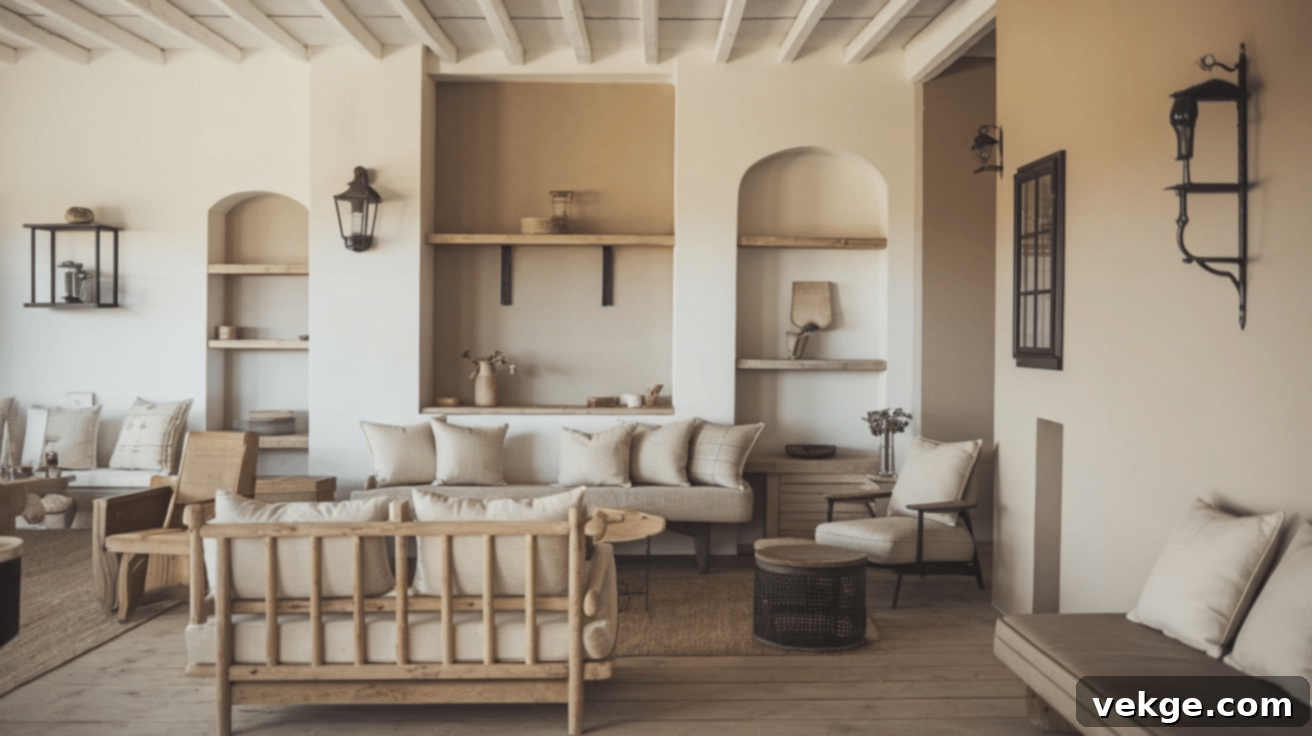
Begin by establishing a foundational neutral color palette for your walls and larger surfaces. Crisp whites, creamy off-whites, or soft beige shades create a clean, expansive, and fresh backdrop that is quintessential to the farmhouse style. To introduce warmth, layer in wooden accents through furniture or decor. For a touch of contemporary contrast, incorporate black metal fixtures or hardware.
If you wish to introduce subtle color, opt for earthy greens, muted blues, or deep, warm browns. These hues complement the natural elements of farmhouse design without overpowering the serene and harmonious feel.
2. Use Wood in Your Design
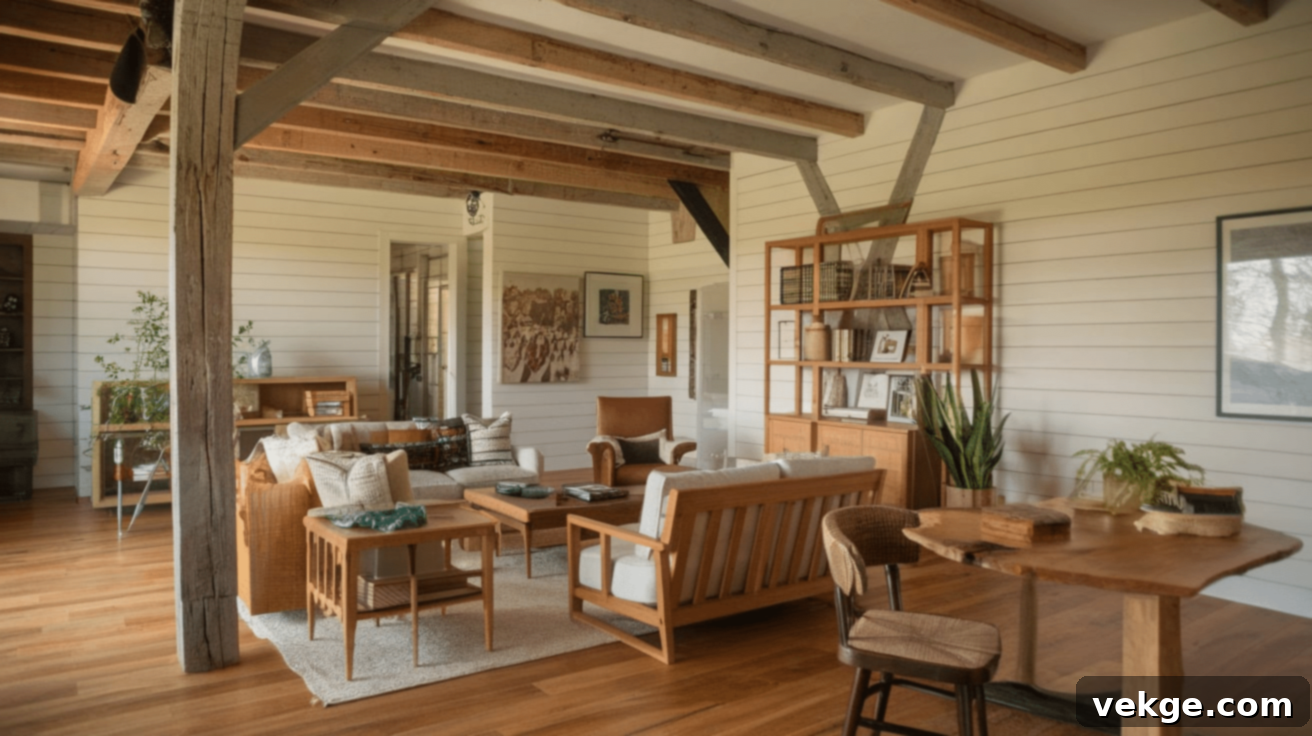
Integrating wood is perhaps the most straightforward and impactful way to achieve a barn farmhouse aesthetic. Consider incorporating it in various forms throughout your home:
- Floors: Opt for hardwood, engineered wood, or even high-quality laminate flooring in warm, natural tones like oak, maple, or pine.
- Walls: Introduce shiplap paneling or reclaimed wood planks on an accent wall to add texture, character, and a rustic touch.
- Ceilings: If feasible, expose existing wooden beams or install decorative faux beams to instantly elevate the rustic charm and architectural interest.
- Furniture: Prioritize sturdy, wooden dining tables, chairs, cabinets, and shelving. Look for pieces with a slightly worn or handcrafted appearance.
3. Add Barn Doors
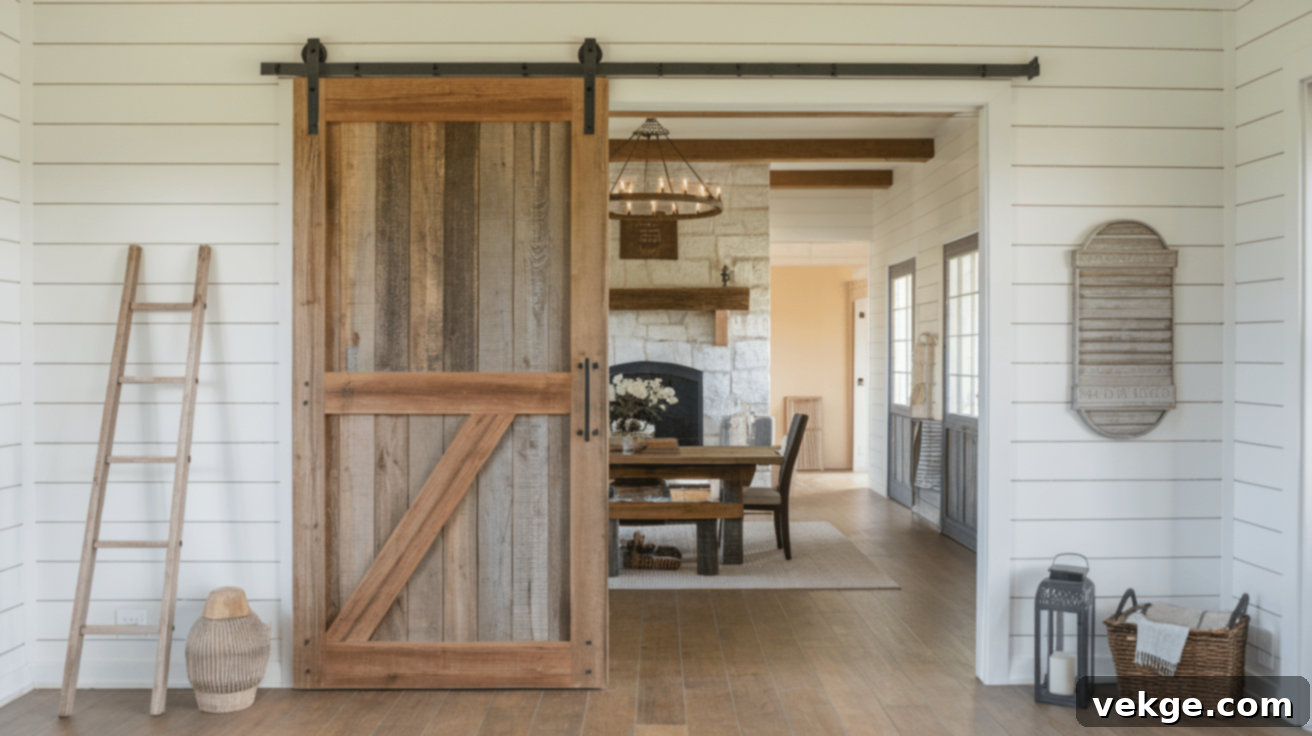
If your space allows, replacing a traditional hinged door with a sliding barn door is a powerful design statement. It not only introduces an instant farmhouse vibe but also offers excellent space-saving benefits, especially in smaller rooms, bathrooms, or as a creative division for open-plan areas. Choose a raw wood finish for ultimate rustic appeal or a painted one (like white or black) for a more refined look.
4. Go for an Open Layout
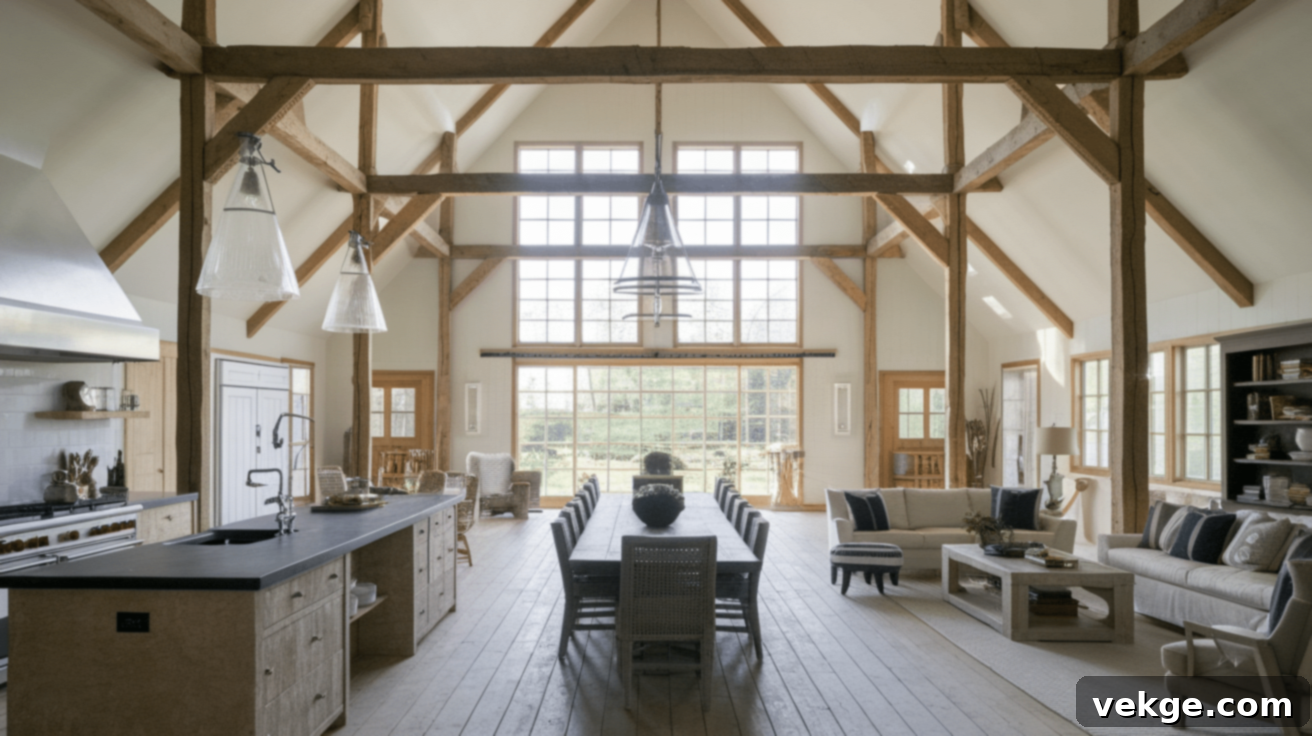
If a renovation is on the horizon, consider removing non-load-bearing walls to create a more open and fluid floor plan. This immediately enhances the sense of space and connection, echoing the original purpose of large barn structures. If a full remodel isn’t feasible, you can still emulate an open feel by strategically arranging furniture. Use area rugs, clever furniture placement, and consistent color palettes to define zones while maintaining a sense of flow and visual connectivity between spaces.
5. Mix Modern and Rustic Elements
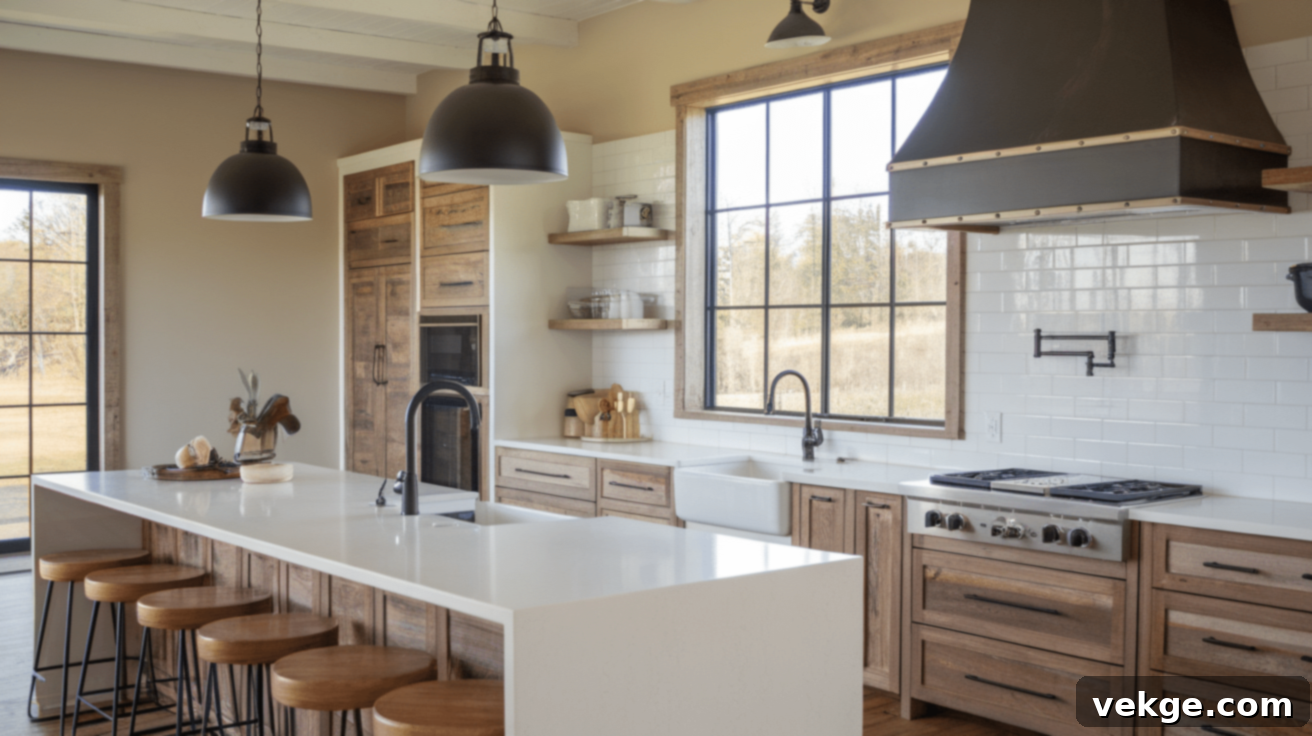
The beauty of the barn farmhouse style often lies in its ability to marry old-world charm with contemporary design. Avoid creating a space that feels like a period museum piece. Instead, introduce modern elements like sleek quartz or concrete countertops, minimalist light fixtures, or clean-lined furniture to achieve a balanced and fresh look. For instance, pairing a distressed reclaimed wood dining table with contemporary black metal chairs creates a dynamic and stylish contrast.
This thoughtful blend of old and new ensures your home feels current and sophisticated while retaining its rustic heart.
6. Incorporate Natural Textures
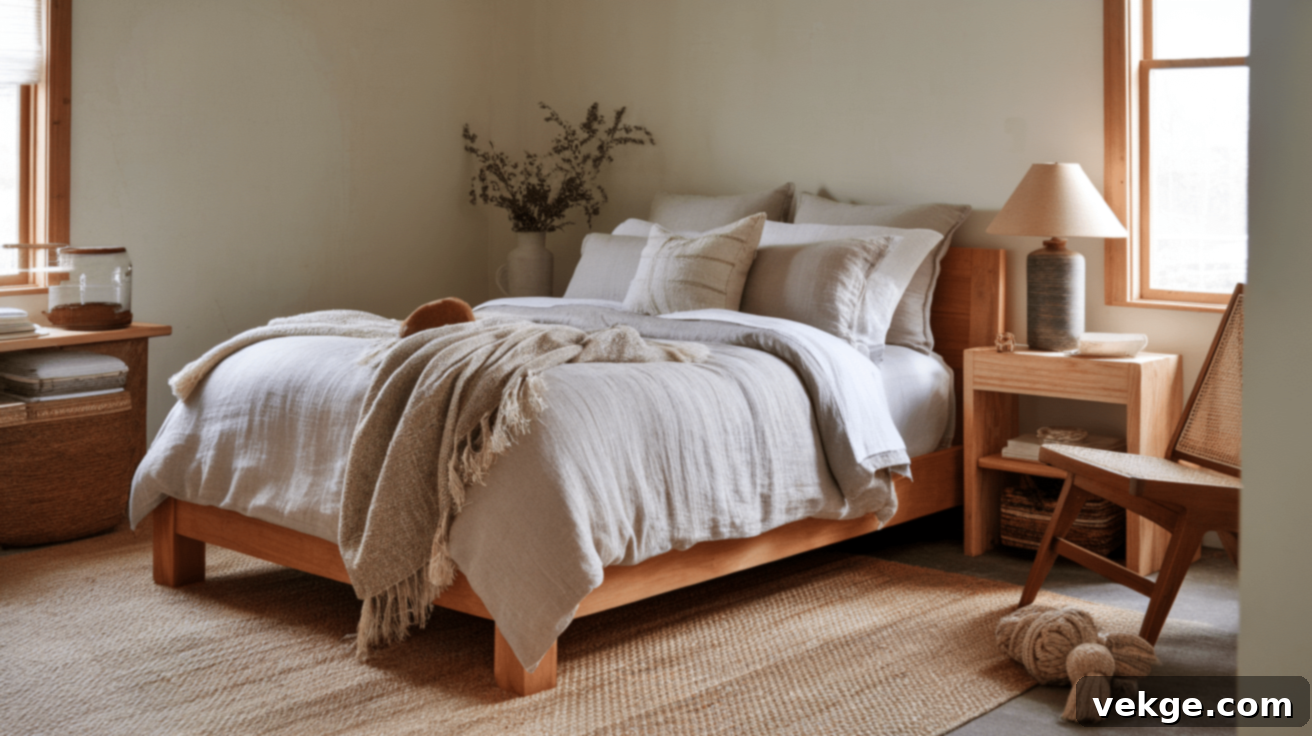
Adding a variety of natural textures is essential for creating a warm, inviting, and layered barn farmhouse interior. Consider the following elements:
- Linen or cotton curtains: Choose light, airy fabrics in neutral tones for a soft, understated window treatment.
- Wool or jute rugs: These natural fiber rugs add warmth, define spaces, and introduce organic texture to your floors.
- Handmade ceramics: Display pottery, stoneware, or other handcrafted items to bring an earthy, artisanal touch to shelves and tabletops.
- Soft throw blankets and pillows: Layer with materials like chunky knits, faux fur, or woven cotton to enhance comfort and visual interest.
Barn Farmhouse Kitchen Ideas
The kitchen is often considered the true heart of a barn farmhouse home, and as such, it should embody warmth, hospitality, and practical functionality. A well-designed barn farmhouse kitchen expertly blends rustic charm with modern conveniences, resulting in a space that is both beautiful and highly efficient. Here are some key design ideas to help you create your ideal farmhouse kitchen:
1. Farmhouse Sink

An undeniable icon of the barn farmhouse kitchen is the apron-front, or farmhouse, sink. These distinctive deep and wide sinks are not only incredibly stylish but also remarkably practical, making light work of washing large pots, pans, and even small children or pets! Their prominent front panel adds a robust, traditional character to the kitchen.
Farmhouse sinks are available in several classic materials:
- Porcelain or fireclay: The quintessential choice, these classic white sinks offer a clean, bright, and traditional look that complements any farmhouse palette.
- Stainless steel: A more contemporary interpretation, stainless steel farmhouse sinks offer exceptional durability and a sleek, modern edge while maintaining the signature apron-front design.
- Copper: For a truly rustic and artisanal feel, copper sinks age beautifully, developing a rich patina over time that adds warmth and unique character.
Pairing a farmhouse sink with a gooseneck or bridge faucet further enhances its classic appeal, completing the authentic farmhouse aesthetic.
2. Open Shelving

In lieu of bulky traditional upper cabinets, many barn farmhouse kitchens embrace open shelving. This design choice instantly creates an airy, relaxed, and approachable feel, allowing for the beautiful display of dishes, glassware, cookbooks, and decorative items. Open shelves also make everyday essentials easily accessible.
To maximize the aesthetic impact of open shelving:
- Install sturdy wooden shelves, ideally with black metal brackets, for a strong rustic industrial touch.
- Curate your displays with white or neutral-colored dishes, plates, and mugs to maintain a clean, cohesive, and simple look.
- Introduce woven baskets, clear glass jars filled with pantry staples, and small potted herbs or plants to add texture, warmth, and a touch of nature.
If you require more concealed storage but still admire the open feel, glass-front cabinets offer a perfect compromise, allowing for display while keeping items dust-free.
3. Wooden or Butcher Block Countertops
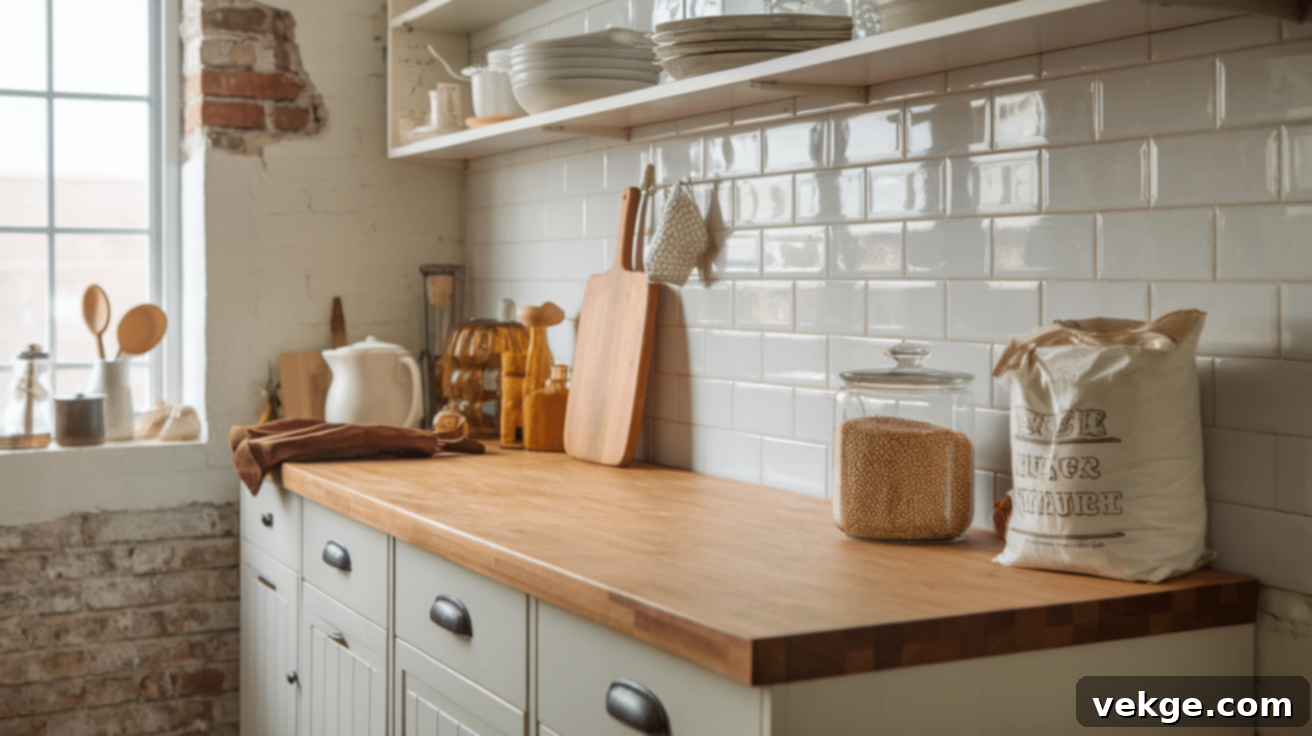
Wood is a staple in farmhouse kitchens, and incorporating it into your countertops brings undeniable warmth, texture, and a tactile quality to the space. Butcher block countertops are a particularly popular choice due to their affordability, natural beauty, and inherent practicality. They are excellent for food preparation, forgiving to knives, and can be easily refinished over time to refresh their appearance.
If wood isn’t your preferred material for all countertops, consider these complementary options:
- Marble or quartz: These materials offer a luxurious, refined contrast to rustic wood, creating a modern farmhouse blend that is both elegant and durable.
- Soapstone: A classic material with a soft, matte finish, soapstone provides a durable and beautiful dark gray or green-black surface that develops a rich patina and complements the earthy aesthetic.
4. Classic White Cabinets
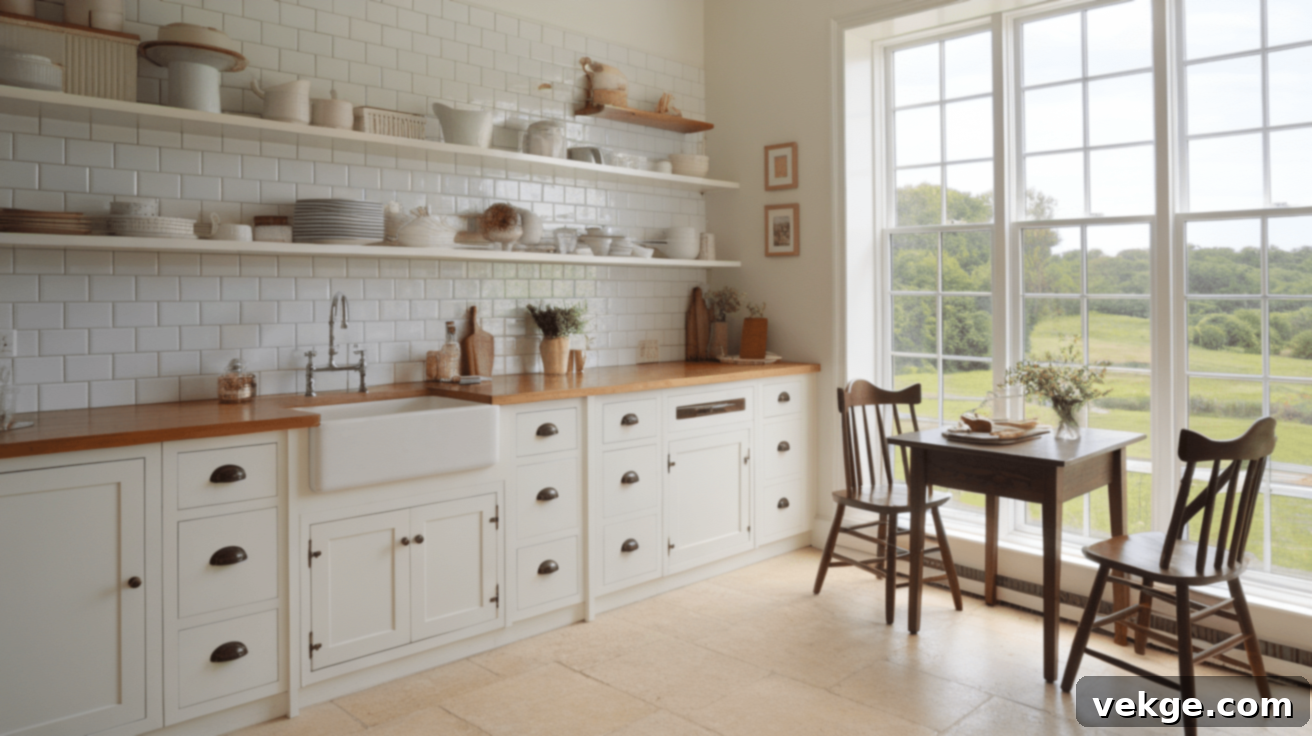
White cabinets are a signature element of farmhouse kitchens, creating a bright, clean, and timeless foundation. They offer incredible versatility, pairing seamlessly with any color scheme and contributing to an overall sense of freshness and spaciousness. To add character and visual interest to your white cabinetry, consider these details:
- Shaker-style cabinets: Their simple, clean lines and recessed panel design are a perfect match for the understated elegance of farmhouse decor.
- Distressed or painted finishes: For a more vintage or rustic look, opt for cabinets with a gently distressed finish or those painted in a soft, antiqued white.
- Glass doors: Incorporate a few cabinets with glass inserts to showcase beautiful dishes or prized heirlooms, adding depth and a custom feel.
For a striking contrast, select hardware in finishes like matte black, antique brass, or oiled bronze. These choices will make your white cabinets truly pop and enhance the overall farmhouse charm.
5. Large Kitchen Island
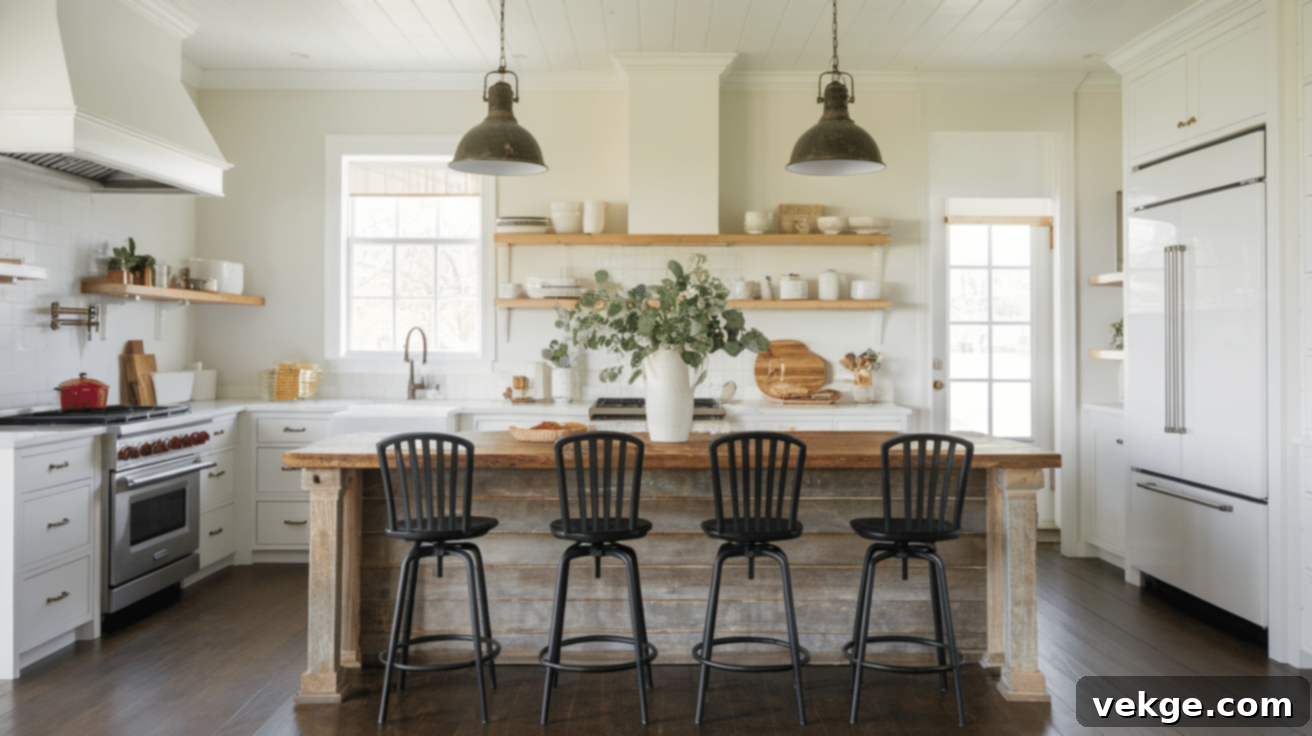
A spacious and inviting kitchen island is an indispensable feature in a barn farmhouse kitchen. It not only provides extensive extra counter space for meal preparation but also serves as a natural gathering spot for family and friends, epitomizing the communal spirit of farmhouse living. It’s where homework happens, coffee is shared, and impromptu conversations unfold.
To design a farmhouse-inspired island:
- Choose a base made from reclaimed wood or a painted finish (like white, gray, or a soft accent color) for a rustic or classic look.
- Pair it with comfortable barstools featuring wooden seats, metal frames, or upholstered tops in natural fabrics.
- Consider a contrasting countertop for the island, such as a rich butcher block paired with quartz or marble on the perimeter counters, to add visual interest and define the space.
Many kitchen islands also incorporate built-in drawers, cabinets, or open shelving, making them a powerhouse for additional storage and organization.
6. Farmhouse Lighting
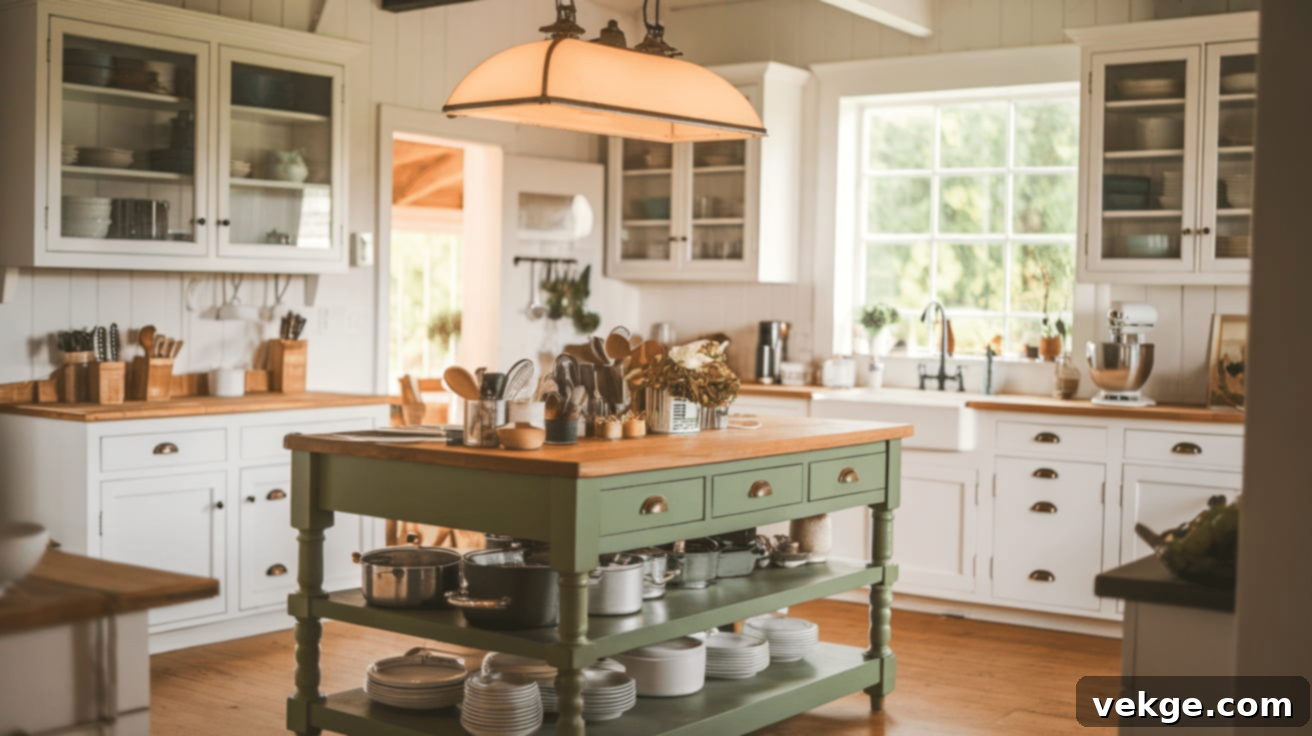
Lighting plays a crucial role in setting the ambiance of a barn farmhouse kitchen, balancing functionality with style. Popular lighting choices that enhance the rustic aesthetic include:
- Black metal or bronze pendant lights: These are ideal for hanging above a kitchen island or peninsula, providing task lighting while serving as stylish focal points.
- Lantern-style fixtures: Evoking a charming vintage farm feel, these fixtures add a touch of antique elegance and warmth.
- Exposed bulb chandeliers: For a modern farmhouse twist, chandeliers featuring exposed Edison bulbs can introduce an industrial-chic element while providing ample ambient light.
Selecting the right lighting not only illuminates your workspace but also significantly contributes to the welcoming and cozy atmosphere of your barn farmhouse kitchen.
Barn Farmhouse Living Room Ideas
The living room in a barn farmhouse should be a sanctuary of comfort and warmth, a space that naturally draws family and guests to gather, relax, and connect. It’s about creating an atmosphere that feels genuinely inviting and unpretentiously comfortable. Here are some inspiring ideas to infuse the barn farmhouse style into your central living space:
1. Cozy Seating
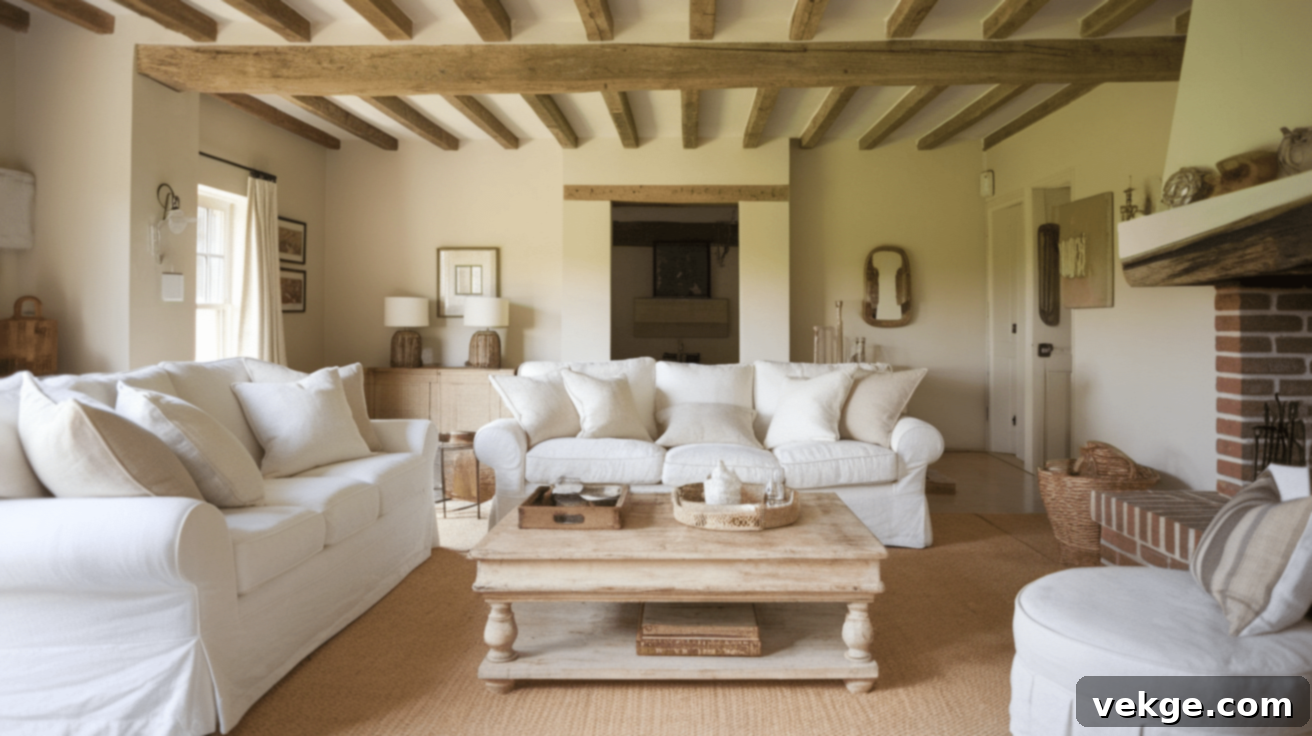
Comfort is paramount in a barn farmhouse living room. Prioritize seating that is plush, durable, and exudes an immediate sense of welcome. Oversized sofas and generously proportioned armchairs are excellent choices, encouraging lounging and relaxation.
Some popular and effective options include:
- Slipcovered sofas: A white or neutral-toned slipcovered sofa offers a relaxed, casual, yet classic farmhouse aesthetic, and is practical for cleaning.
- Leather armchairs: A rich, distressed leather armchair introduces warmth, texture, and a timeless, sophisticated ruggedness.
- Plush cushions and throw blankets: Layer your seating with an abundance of soft textiles in natural fabrics like linen, cotton, wool, or faux fur to enhance coziness and visual depth.
The key is to thoughtfully mix textures while adhering to a soft, neutral color palette, creating an irresistible invitation to unwind.
2. Fireplace With Wooden Mantel
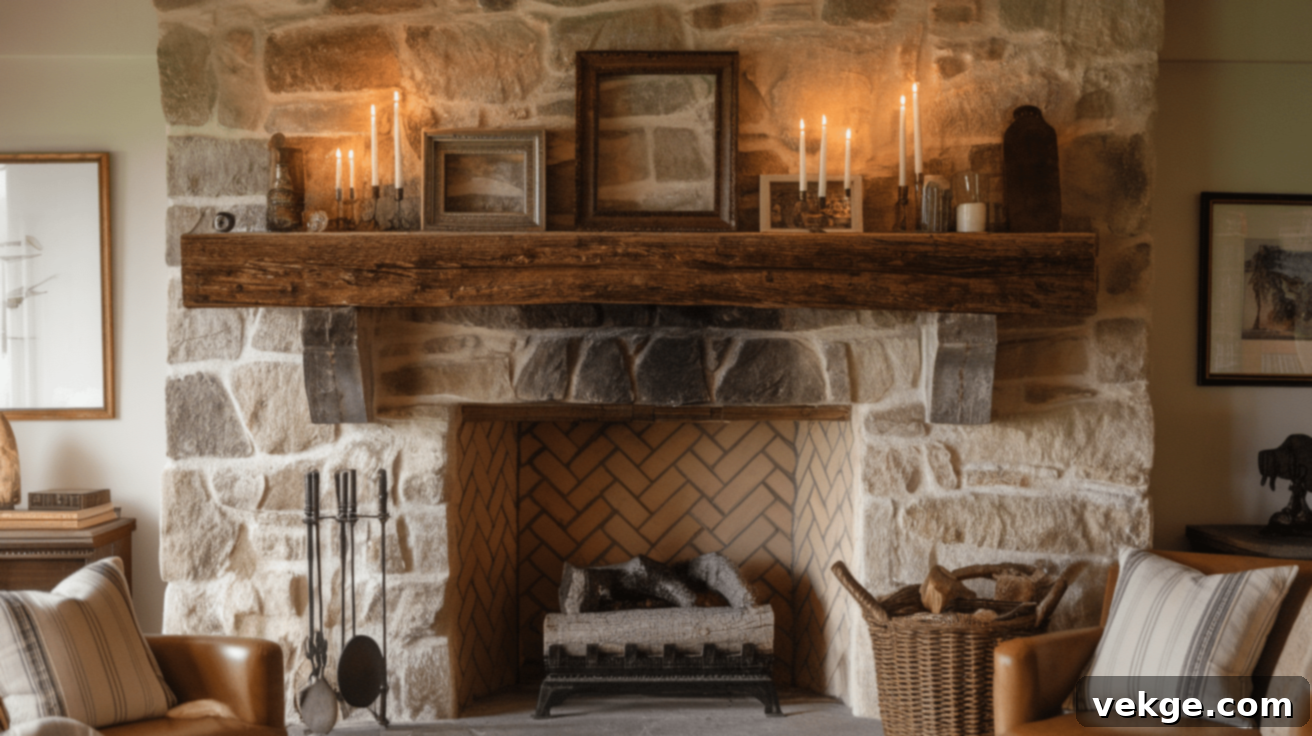
A fireplace serves as the quintessential signature feature of a farmhouse living room, instantly imbuing the space with warmth and a focal point for gathering. Whether it’s a traditional wood-burning, a convenient gas, or a modern electric unit, a fireplace significantly elevates the cozy factor.
To enhance its farmhouse character:
- Install a chunky reclaimed wood mantelpiece to introduce authentic rustic charm and a sense of history.
- Surround the firebox with natural materials like brick or stone veneer to add texture and a grounded, organic feel.
- Adorn the mantel with carefully selected decor: a collection of vintage candles, framed botanical prints, antique finds, or a rustic clock.
Even without a built-in fireplace, a freestanding wood stove or an electric fireplace insert can create a similar welcoming ambiance.
3. Layered Rugs for Warmth
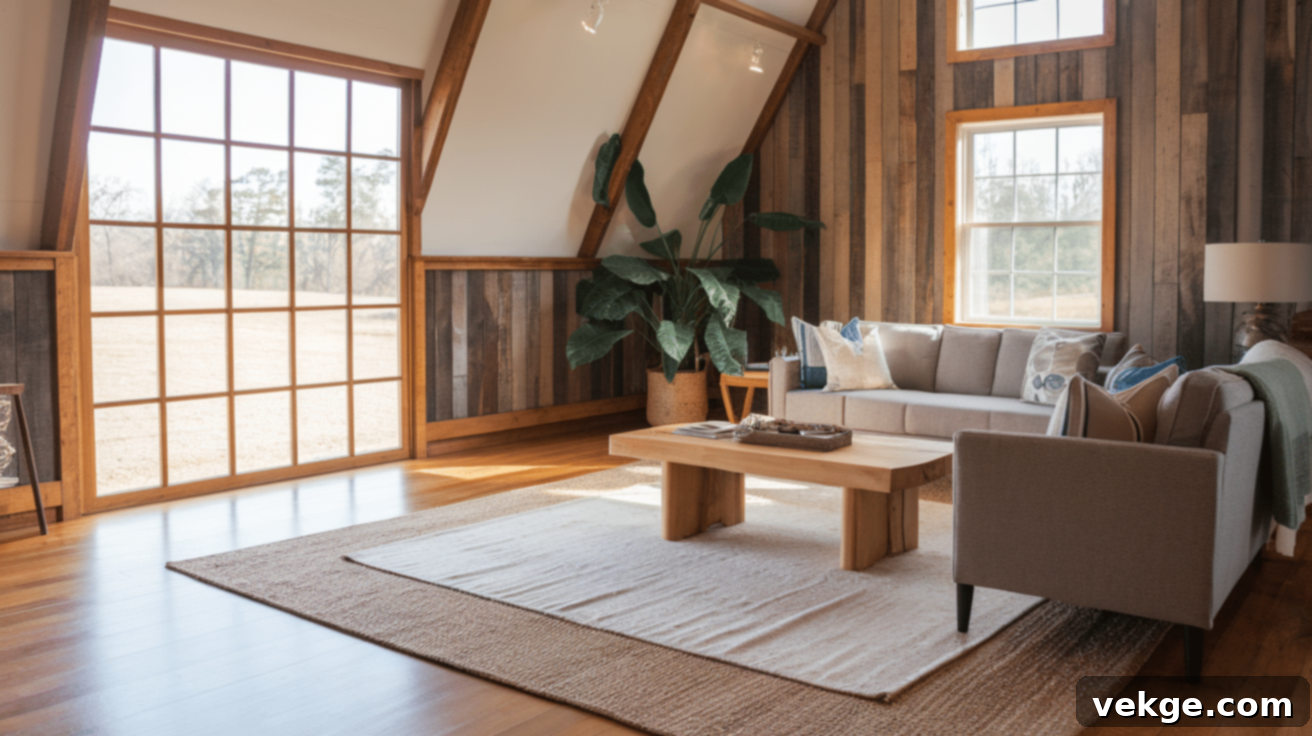
Layering rugs is a simple yet incredibly effective design technique to make a living room feel extra cozy, adding both warmth and visual interest to your floors. Start with a larger, foundational rug made of a natural fiber like jute, sisal, or a low-pile wool in a neutral tone. Then, layer a smaller, softer rug on top, such as a plush wool, cotton, or even a vintage-style rug.
Popular rug choices for a barn farmhouse living room include:
- Neutral-toned wool rugs: Offering softness underfoot and timeless appeal, often in cream, beige, or light gray.
- Patterned vintage rugs: These add a unique layer of character, history, and a subtle pop of muted color.
- Plaid or checkered rugs: A classic farmhouse motif that can introduce a playful yet traditional element.
4. Large Windows with Simple Curtains
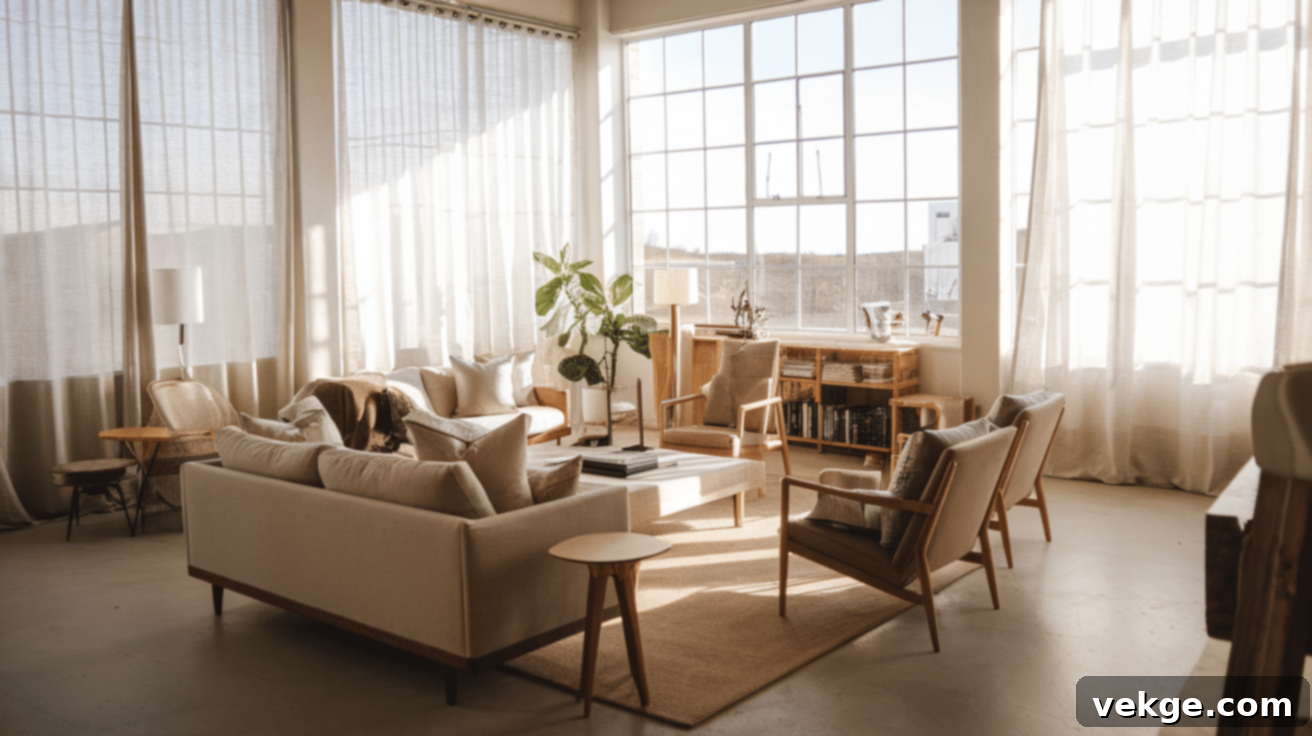
Consistent with the overall barn farmhouse philosophy, the living room should be bathed in natural light. Large windows are crucial for this, ensuring the space feels open, bright, and connected to the outdoors. If your windows are on the smaller side, opt for light-colored, sheer, or semi-sheer curtains to maximize the light entry and enhance the room’s sense of airiness.
For an authentic farmhouse look, consider these choices for window treatments:
- Linen or cotton curtains in soft whites, creams, or light beiges, offering a relaxed and organic texture.
- Simple wooden curtain rods or understated black metal rods to complement the rustic aesthetic without drawing undue attention.
- Sheer curtains provide a degree of privacy while still allowing an abundance of natural light to filter through, maintaining a fresh and welcoming feel.
5. Vintage and Handmade Decor
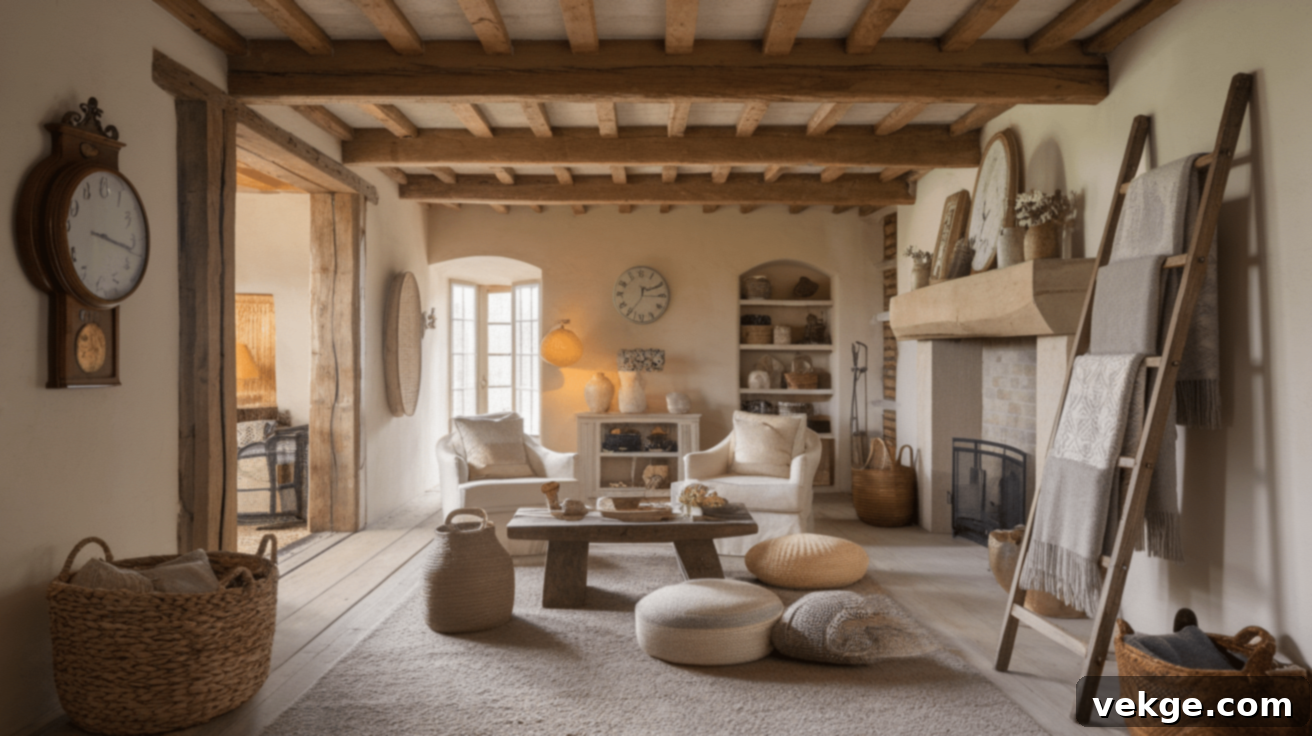
Farmhouse living rooms thrive on character and personality, which is best achieved through thoughtfully curated decor. Rather than selecting trendy, mass-produced items, focus on acquiring pieces that feel personal, have a story, and possess a timeless quality. Scour antique shops, flea markets, and local artisan craft fairs.
Some inspiring decor ideas include:
- Antique mirrors: These not only add depth and visual interest but also reflect light, making the room feel larger and brighter.
- Wooden crates or trunks: Repurposed as coffee tables, side tables, or simply decorative accents, they offer both rustic charm and practical storage.
- Framed botanical prints or farm-inspired artwork: Delicate prints of plants, animals, or rural landscapes add a refined natural touch.
- Handwoven baskets: Functional and decorative, they can be used for storing blankets, magazines, or as stylish planters.
By incorporating small, meaningful touches, your living room will truly feel like a unique and inviting home.
Barn Farmhouse Bedroom Ideas
The bedroom in a barn farmhouse should serve as a serene and peaceful retreat, a deeply comforting and inviting sanctuary for rest and rejuvenation. The key is to blend simple, rustic elements with soft, natural fabrics to create an atmosphere of ultimate relaxation. Here are some ideas to transform your bedroom into a tranquil farmhouse haven:
1. Wood or Metal Bed Frame
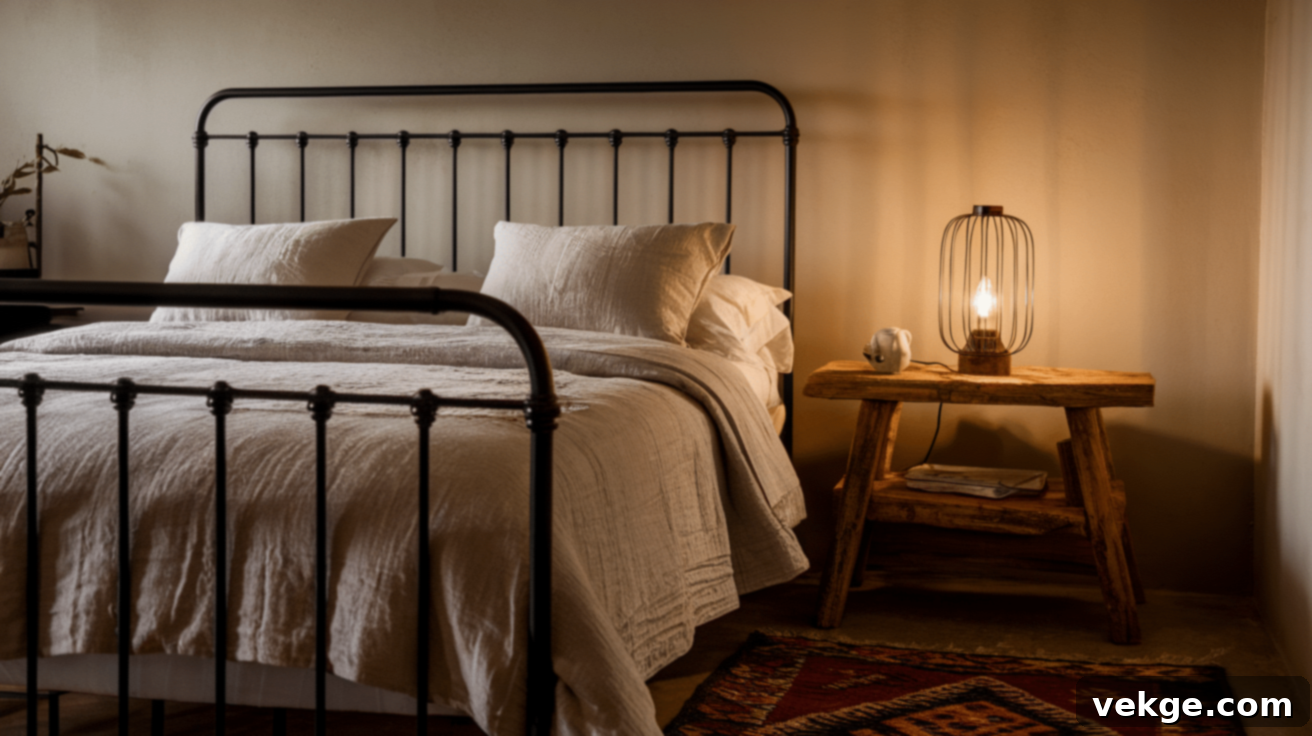
A barn farmhouse bedroom calls for a bed frame that is both simple in design and robust in presence. Two classic and highly effective choices are:
- A wooden bed frame: Whether in its natural, unfinished state to highlight grain and texture, or painted in a soft white or cream, a wooden bed frame anchors the room with rustic charm.
- A black metal bed frame: This offers a classic, slightly industrial farmhouse look that pairs beautifully with a range of bedding and decor styles, providing a subtle contrast.
2. Soft, Neutral Bedding
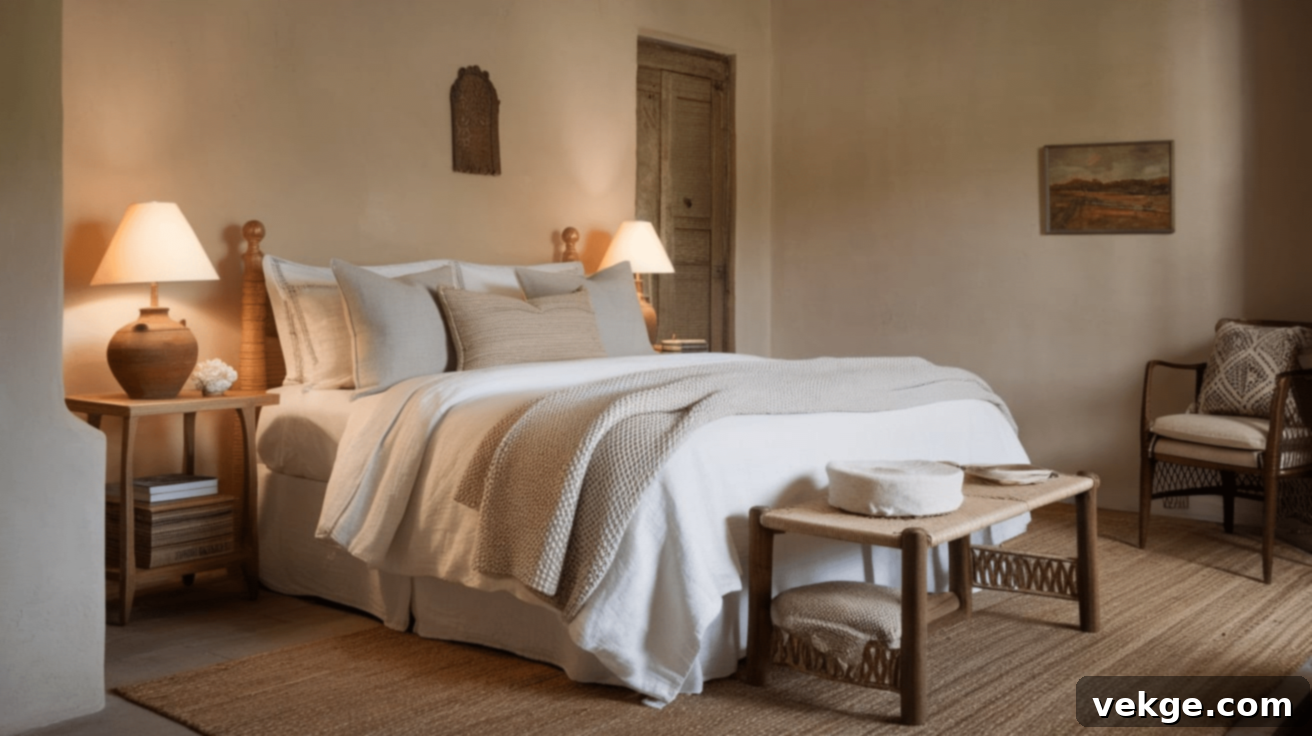
Farmhouse bedding is all about creating a sense of luxurious softness and undeniable coziness. Stick to light, natural colors and layer different textures to build a warm, inviting sleeping space. The aim is comfort without fuss.
Popular choices for bedding include:
- White or beige linen sheets: Known for their breathability, durability, and casually elegant drape, linen sheets are both timeless and incredibly comfortable.
- Knit blankets or quilts: Layering with a chunky knit throw, a classic cotton quilt, or a chenille blanket instantly adds warmth, texture, and a handcrafted feel.
- Plaid or floral accent pillows: Introduce subtle patterns with a few accent pillows featuring classic farmhouse motifs like muted plaids, gingham, or delicate florals.
3. Wooden Nightstands and Dressers

Wooden furniture is fundamental in a barn farmhouse bedroom. Look for nightstands and dressers crafted from solid wood, ideally with a distressed finish or made from reclaimed timber, to instantly inject character and a sense of history into the room. These pieces should feel sturdy and enduring.
For a slightly softer or more refined farmhouse aesthetic, consider furniture painted in a creamy white or light gray, perhaps adorned with antique-style metal knobs or cup pulls for a touch of vintage charm.
4. Simple Lighting and Decor
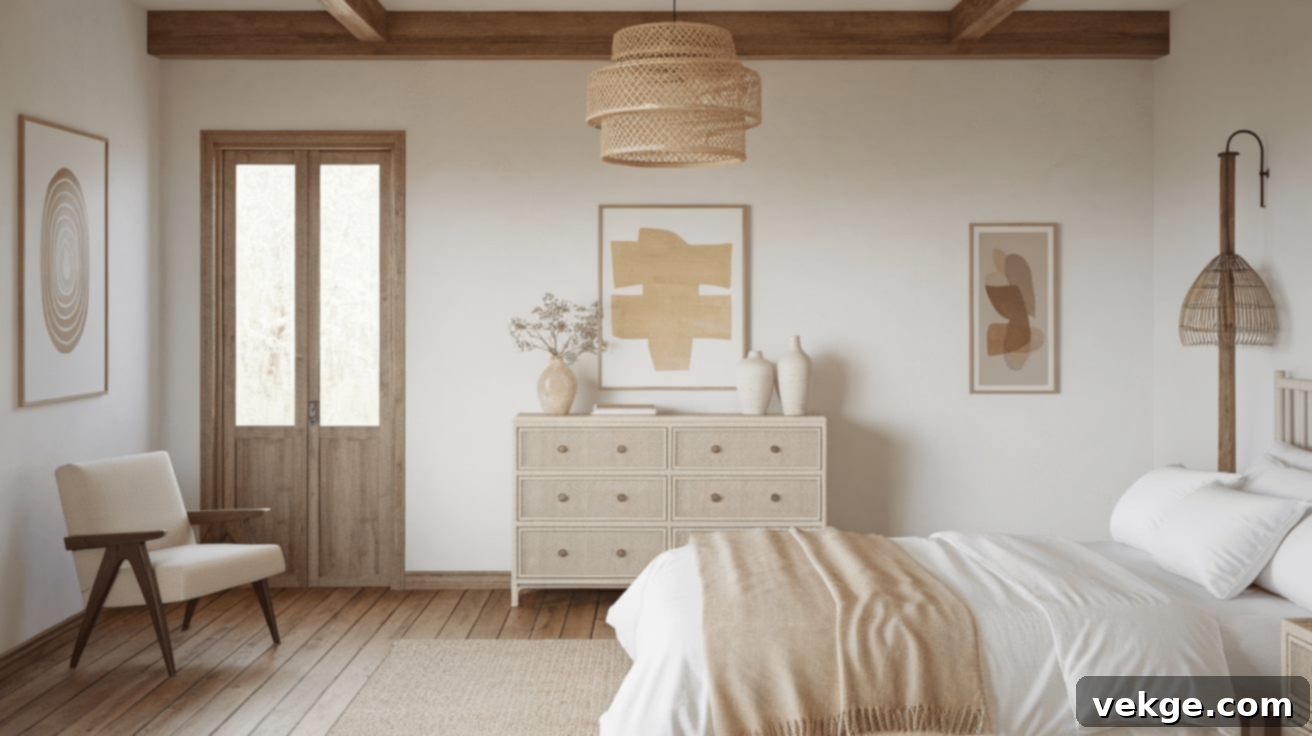
In a barn farmhouse bedroom, decor should be kept minimal yet meaningful. Focus on a few key touches that enhance the serene and personal atmosphere without cluttering the space:
- Bedside lamps with warm, ambient lighting, perhaps featuring ceramic bases or linen shades.
- A simple wooden or black metal chandelier or a flush-mount fixture to provide overhead illumination without being overly ornate.
- A few vintage framed art pieces, such as botanical prints, landscape sketches, or antique family photos.
- A cozy area rug, in a neutral tone or a subtle pattern, placed under or beside the bed to add softness, warmth, and anchor the furniture.
By consciously keeping things simple and selecting items with purpose and beauty, your bedroom will effortlessly become a calm and inviting retreat.
DIY Barn Farmhouse Projects
If you’re passionate about the barn farmhouse style and eager to infuse your home with personalized, handcrafted touches, DIY projects offer a fantastic avenue. Many farmhouse-inspired pieces can be surprisingly easy and affordable to create using readily available materials like wood, metal, and paint. These projects not only add character but also allow you to express your unique style. Here are some simple DIY projects that can bring that beloved farmhouse charm directly into your home:
1. DIY Sliding Barn Door
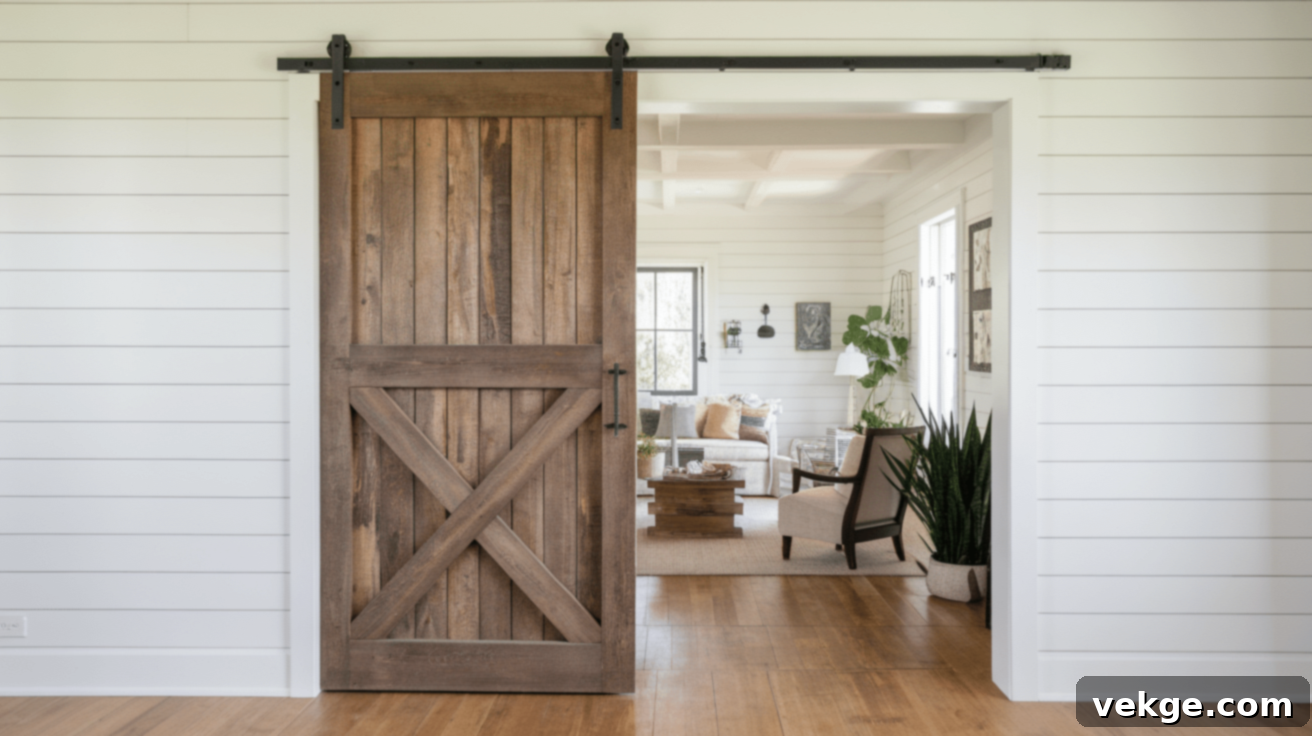
A sliding barn door is a quintessential farmhouse feature that instantly elevates any space. Instead of purchasing a pre-made door, which can be costly, you can construct your own with a few basic tools and materials, tailoring it perfectly to your home’s dimensions and style.
What You’ll Need
- Wooden boards (pine, common board, or reclaimed wood for an authentic look)
- Wood stain or paint (white, gray, or a natural wood tone)
- Sliding barn door hardware kit (readily available online or at home improvement stores)
- Screws and a power drill
- Sandpaper or a power sander
- Measuring tape and saw
Steps
- Cut and Arrange the Wood: Accurately measure your doorway opening. Cut your wooden boards to the appropriate height and width. Arrange them in your desired vertical pattern, ensuring a snug fit.
- Attach Cross Planks: Secure horizontal or diagonal planks across your vertical boards. These not only provide structural support but also contribute to the classic barn door aesthetic.
- Sand and Stain/Paint: Thoroughly sand all surfaces and edges to ensure a smooth finish. Apply your chosen wood stain or paint, allowing it to dry completely. For a distressed look, lightly sand edges after painting.
- Install the Hardware: Following the manufacturer’s instructions, install the sliding track above your doorway. Attach the rollers and handles to your newly built door, then carefully mount it onto the track.
This DIY project adds a truly custom, rustic touch to any room and is an excellent solution for saving space where a traditional swinging door would be impractical.
2. Distressed Farmhouse-Style Furniture

Distressed or aged-looking furniture is a cornerstone of farmhouse decor, lending an immediate sense of history and charm. Instead of investing in expensive vintage pieces, you can easily achieve this coveted look yourself, transforming new or existing furniture.
What You’ll Need
- A wooden piece of furniture (table, dresser, nightstand, chair)
- Medium-grit and fine-grit sandpaper or a sanding block
- White, gray, or neutral-toned chalk paint (or latex paint with a primer)
- Paintbrush
- Clear wax or polyurethane sealant
Steps
- Sand the Surface: Lightly sand the entire surface of your furniture piece to create a smooth base and help the paint adhere better. Clean off any dust.
- Apply Chalk Paint: Apply one to two coats of your chosen chalk paint. Chalk paint is excellent for this technique as it adheres well and provides a matte, rustic finish. Let it dry completely between coats.
- Distress the Edges: Once the paint is fully dry, use sandpaper (medium-grit first, then fine-grit) to gently rub off paint along the edges, corners, and any raised details. Focus on areas that would naturally show wear and tear over time.
- Seal the Finish: To protect your newly distressed piece, apply a thin, even layer of clear wax or a matte polyurethane sealant. This will make the furniture durable for everyday use.
This versatile project works beautifully on both old and new wooden furniture, offering an easy and impactful way to inject character into your home’s decor.
3. DIY Wooden Floating Shelves
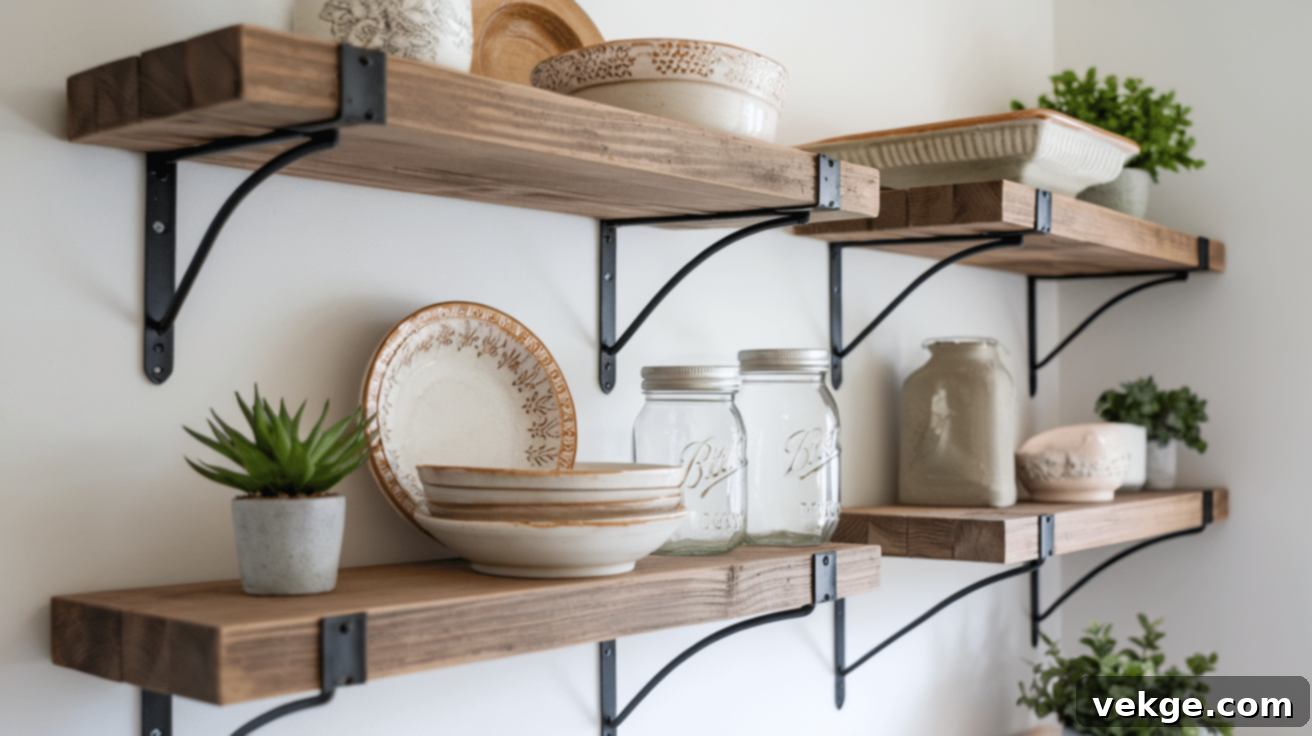
Floating shelves are a highly functional and aesthetically pleasing addition to farmhouse-style kitchens, bathrooms, living rooms, and bedrooms. They provide open storage and display opportunities without the visual bulk of traditional cabinets. Creating your own floating shelves allows for custom sizing and finish, often at a fraction of the cost of store-bought alternatives.
What You’ll Need
- Solid wooden planks (choose appropriate length and depth for your space)
- Wood stain or paint
- Floating shelf brackets (L-brackets or hidden shelf brackets for a true floating look)
- Screws, wall anchors, and a power drill
- Level and measuring tape
Steps
- Cut and Stain/Paint the Wood: If necessary, cut your wooden planks to the desired length. Sand them smooth, then apply your chosen wood stain (for a warm, natural look) or paint (for a whitewashed or neutral finish). Allow to dry completely.
- Attach Brackets to the Wall: Determine the placement of your shelves. Using a level, mark the positions for your brackets. Securely attach the floating shelf brackets to wall studs or use heavy-duty wall anchors for maximum stability.
- Mount the Shelves: Carefully slide or attach your prepared wooden planks onto the brackets. Ensure they are level and securely fastened. For hidden brackets, this step typically involves sliding the wood over the protruding metal rods.
Once installed, these shelves are perfect for showcasing mason jars, vintage plates, charming woven baskets, small potted plants, or framed photos, instantly adding a personalized farmhouse touch to your room.
4. DIY Farmhouse Sign
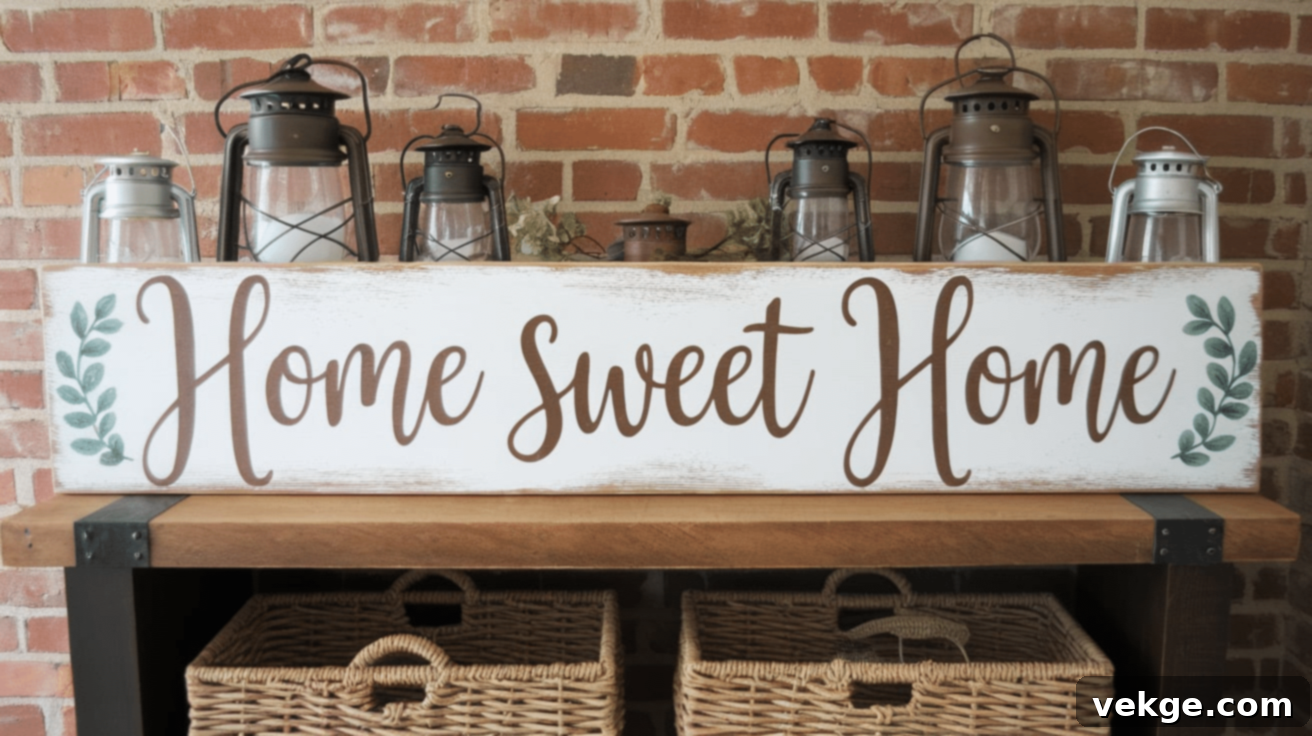
A custom farmhouse-style wooden sign is a delightful and impactful piece of decor that can enhance the warmth and personality of any room. This project allows for endless customization, whether you choose to feature your favorite family quote, your family name, or simple, evocative words like “Gather,” “Home,” or “Farm Fresh.”
What You’ll Need
- A wooden board (a plank, pallet wood, or plywood cut to size)
- Wood stain or paint (white, black, gray, or a rustic wood tone)
- Stencils, a vinyl cutting machine, or a printable design for transferring text
- Paintbrushes, foam brushes, or a paint pen
- Fine-grit sandpaper
- Optional: Sawtooth hanger for mounting
Steps
- Stain or Paint the Board: Begin by preparing your wooden board. Sand it smooth, then apply your chosen stain for a rustic wood background or paint it white, black, or gray for a classic farmhouse look. Allow it to dry completely.
- Transfer the Design: If using stencils, position them carefully. If transferring a printed design, you can rub chalk on the back of the printout, then trace the design onto the board to leave a chalk outline.
- Paint the Letters: Using a small paintbrush or a paint pen, carefully fill in your design. Black, white, or dark gray paint typically works best for crisp, legible farmhouse text. Apply multiple coats if needed.
- Distress the Edges: Once the paint is dry, lightly sand the edges and perhaps a few areas on the surface of the sign with fine-grit sandpaper. This creates a worn, aged effect that enhances the farmhouse charm.
Hang your finished DIY farmhouse sign in your kitchen, entryway, living room, or bedroom to beautifully complete your home’s inviting farmhouse ambiance.
Conclusion
The barn farmhouse style is more than just an interior design trend; it’s an enduring philosophy for creating a home that feels genuinely warm, welcoming, and rich in character. By thoughtfully integrating the ideal balance of rustic elements with subtle modern touches, any house can be transformed into a charming farmhouse haven, regardless of its location or original architecture.
The strategic use of natural materials such as wood, stone, and metal is paramount in evoking the authentic farmhouse feel, celebrating their raw beauty and texture. A palette of neutral and earthy colors maintains a serene, simple, and timeless aesthetic, allowing these natural elements to shine. Design choices like open layouts, generous large windows, and an emphasis on cozy, inviting decor all contribute to a home that feels bright, spacious, and irresistibly welcoming.
Furthermore, attention to small yet impactful details—such as the installation of sliding barn doors, the inclusion of vintage furniture pieces, and the integration of handmade accents—adds layers of personality and a bespoke charm. Embarking on DIY projects, like distressing furniture or crafting wooden shelves, offers a budget-friendly and deeply satisfying way to infuse your home with this distinctive style, making a significant difference with relatively simple updates.
Ultimately, the art of the barn farmhouse lies in its harmonious blend of old and new. By thoughtfully pairing traditional rustic elements with sleek, modern finishes and functionalities, you can achieve a home that is both comfortably lived-in and refreshingly stylish. Embrace these ideas, experiment with combinations, and truly make the barn farmhouse style a unique reflection of your own taste and lifestyle.
Frequently Asked Questions
How Is a Barn Farmhouse Different from A Regular Farmhouse?
While both styles share a love for rustic elements, a barn farmhouse typically features a more expansive and open layout, often incorporating soaring vaulted ceilings with exposed wooden beams. It emphasizes larger windows to maximize natural light and a more industrial-rustic aesthetic inspired by the grandeur of actual barns. Traditional farmhouses, in contrast, may feature smaller, more segmented rooms and a cozier, sometimes more enclosed, feel.
What Colors Work Best for A Barn Farmhouse?
The most effective color palette for a barn farmhouse revolves around serene neutrals and soft earth tones. Think crisp whites, warm off-whites, inviting beiges, and various shades of gray. These colors create a bright, clean, and calming backdrop. For subtle accents and deeper interest, homeowners can strategically introduce touches of matte black (for hardware or window frames), muted greens (like sage or olive), or deep blues.
How Can I Mix Modern and Barn Farmhouse Styles?
Achieving a balanced modern barn farmhouse look requires thoughtful integration. The key is to pair the rustic warmth of natural wood and traditional textures with the clean lines and functionality of modern design. For instance, combine a reclaimed wood dining table with sleek, contemporary chairs. Incorporate black metal accents in lighting and hardware, choose minimalist, clean-lined decor, and opt for smooth surfaces like quartz countertops, all while maintaining prominent natural wood elements, open spaces, and warm textiles.
Can I Create a Barn Farmhouse Look in A Small Home?
Absolutely! The barn farmhouse style can be successfully adapted to smaller homes. To maximize the sense of space, utilize light and bright paint colors, embrace open shelving instead of bulky cabinets, and strategically place large mirrors to reflect light and expand the room visually. Focus on small yet impactful details: incorporate barn-style lighting fixtures, add wooden accents through furniture or decor, and select vintage finds that are proportionate to your space. These elements effectively bring the cozy, rustic charm without overwhelming a compact area.
How Do I Decorate a Barn Farmhouse Kitchen?
To decorate a barn farmhouse kitchen, focus on functional and charming elements. Install an iconic apron-front farmhouse sink, incorporate open shelving to display white or neutral dishes, and opt for wood or butcher block countertops. Use classic white Shaker-style cabinets, often complemented by black or antique brass hardware. Integrate a large kitchen island as a central gathering point, and illuminate the space with rustic pendant lights or lantern-style fixtures. Finish the look with vintage signs, woven baskets, and plenty of natural textures.
